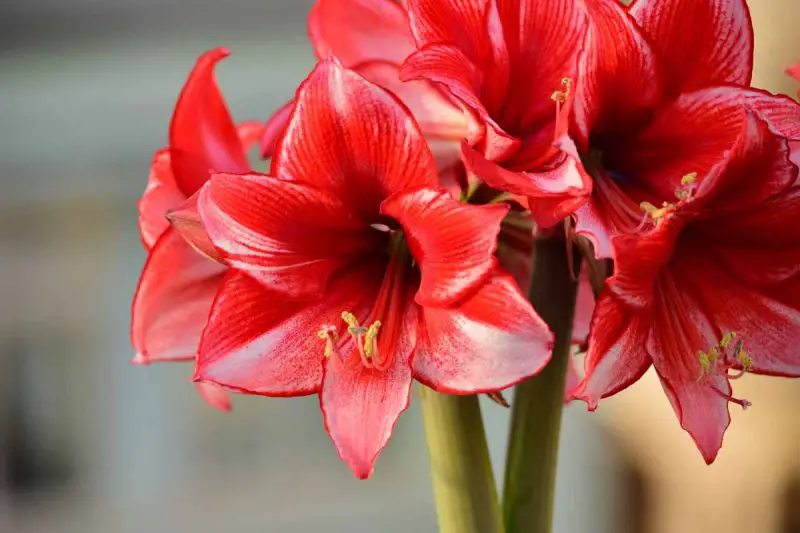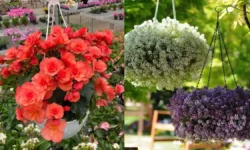Amaryllis plants are known for their bright, trumpet-shaped flowers that add a splash of color to any indoor or outdoor space. To enjoy their beautiful blooms year after year, it’s important to learn how to care for them properly.
This detailed guide will walk you through each step of growing amaryllis—from choosing the right bulbs to providing the best growing conditions and keeping the plant healthy throughout its blooming cycle. Following these tips will help you grow stunning and vibrant amaryllis flowers.
Table of Contents
Understanding Amaryllis and Its Appeal

Amaryllis, scientifically classified in the genus Hippeastrum, is a bulbous flowering plant native primarily to South America. Its large, colorful flowers in shades ranging from fiery reds to soft pinks and whites have made it a favorite holiday and indoor plant worldwide. Unlike many flowering plants that bloom for a short time, amaryllis flowers can last several weeks, brightening up the space with their impressive size and vivid hues.
One reason amaryllis is so beloved is its relatively easy care requirements compared to other flowering bulbs. Still, proper attention to planting, watering, light, and fertilization is vital to encourage healthy growth and repeat blooming in subsequent seasons. Amaryllis bulbs store energy underground, and this reserve supports the dramatic flower stalk that can reach up to two feet tall.
Selecting the Right Amaryllis Bulb
The journey to stunning blooms starts with choosing a high-quality amaryllis bulb. Bulbs come in various sizes, and generally, larger bulbs tend to produce more robust flowers and multiple flower stalks. When purchasing a bulb, look for one that feels firm and heavy for its size. Avoid bulbs that are soft, shriveled, or have visible signs of mold or damage, as these are less likely to produce healthy plants.
The variety of amaryllis you select also influences the flower’s color, shape, and blooming period. Some popular cultivars offer classic red flowers, while others bloom in white, pink, orange, or even striped patterns. Deciding whether you want a single or double-flowered variety, or one with a particular bloom size, can help you narrow down your options. Many garden centers offer bulbs pre-packaged with detailed planting instructions, which can be helpful for beginners.
Preparing to Plant Your Amaryllis
Amaryllis bulbs thrive when planted in well-draining soil and pots with good drainage holes. Choosing the right container is crucial to prevent root rot, a common issue when water accumulates at the bottom of the pot. A medium-sized container, about one to two inches larger than the bulb diameter, provides ample space for roots to grow without excessive soil that can retain moisture.
Before planting, it’s beneficial to soak the bulb’s roots in lukewarm water for a few hours if they appear dry. This encourages quick root development after planting. Fill the pot with a rich, loose potting mix designed for bulbs or indoor plants. Position the bulb so that the top third remains above the soil surface, leaving the roots covered. This ensures proper air circulation around the bulb neck and helps prevent fungal diseases.
Ideal Growing Conditions for Amaryllis
One of the keys to successful amaryllis care is replicating its natural growing conditions as closely as possible. Amaryllis bulbs prefer warm temperatures, moderate humidity, and bright but indirect light.
Light Requirements
Amaryllis plants need plenty of sunlight to fuel their growth and blooming. Placing the pot near a sunny window that receives at least six hours of bright, indirect light daily is ideal. Direct sunlight can sometimes be too intense, especially during the hottest parts of the day, potentially scorching the leaves. If natural light is insufficient, supplemental grow lights can help maintain the plant’s health and encourage vibrant flowers.
Temperature and Humidity
Amaryllis thrives best in temperatures ranging between 65°F to 75°F (18°C to 24°C) during the day, with slightly cooler nights. Avoid exposing the plant to drafts or sudden temperature fluctuations, which can stress the bulb and hinder blooming. While amaryllis tolerates average indoor humidity, maintaining moderate humidity levels benefits overall plant vigor. If your home is dry, placing a humidity tray or misting the leaves occasionally can improve conditions.
Watering Your Amaryllis Properly
Watering is a crucial aspect of amaryllis care that requires balance. Overwatering is the most common mistake and can cause bulb rot, while underwatering leads to poor growth and fewer blooms.
After planting, water the soil thoroughly but ensure excess water drains away freely. During the initial growth phase, when the shoot first appears, keep the soil consistently moist but not soggy. Once the flower stalk starts to elongate and buds develop, reduce watering slightly to avoid encouraging foliage over flower growth.
After the plant finishes blooming, continue watering while the leaves remain green, as they replenish the bulb’s energy reserves. When the foliage yellows and dies back naturally, reduce watering to almost none and allow the bulb to enter dormancy.
Fertilizing for Maximum Bloom Potential
Fertilizing your amaryllis ensures it receives the necessary nutrients for lush foliage and spectacular flowers. Using a balanced, water-soluble fertilizer every two to four weeks during the active growing season supports healthy development.
Choosing a fertilizer with a slightly higher phosphorus content (the middle number in N-P-K ratios) encourages strong flower production. Avoid excessive nitrogen, which promotes leaf growth at the expense of flowers. Feeding should start once new growth emerges and continue until the plant goes dormant. After the flowering cycle, some gardeners choose to fertilize occasionally to help the bulb rebuild energy stores for the next bloom.
Supporting and Pruning Your Amaryllis
Amaryllis flower stalks can grow tall and sometimes become top-heavy, especially with larger blooms. Supporting the stalk with a soft plant stake can prevent bending or breaking. Avoid tying too tightly; the goal is gentle support that allows some natural movement.
Once the flowers fade, it is essential to remove spent blooms to prevent the plant from wasting energy producing seeds. This process, called deadheading, encourages the bulb to focus energy on replenishing for future growth rather than seed formation.
Pruning the leaves should be done only after they yellow and die back naturally. Cutting back green leaves prematurely can weaken the bulb and reduce the chance of blooming next season.
Encouraging Amaryllis to Bloom Year After Year
Unlike some bulbs that bloom once and decline, amaryllis bulbs can flower repeatedly with proper care and rest. After the blooming period ends and leaves die back, the bulb enters a dormancy phase. During dormancy, reducing water and allowing the bulb to rest in a cool, dry place for about eight to twelve weeks is essential.
After this rest period, repotting or refreshing the soil can invigorate the bulb. Start watering again and move the plant to a warm, bright location to encourage new growth. Following this natural cycle of growth, bloom, and dormancy helps maintain a healthy bulb and ensures dazzling flowers each season.
Common Problems and How to Avoid Them
Caring for amaryllis is generally straightforward, but some common issues can arise if conditions are not ideal.
Bulb Rot
Bulb rot is a fungal problem caused by overwatering or poor drainage. Symptoms include soft, mushy bulbs and a foul smell. Preventing this involves using well-draining soil, pots with drainage holes, and watering only when the soil surface is dry.
Pests
Although amaryllis is relatively pest-resistant, spider mites, aphids, and mealybugs can occasionally appear. Regularly inspecting the plant and wiping leaves clean with a damp cloth can help control infestations. For severe cases, gentle insecticidal soap treatments can be applied.
Leaf Yellowing and Dropping
Yellowing leaves often indicate natural aging, especially after flowering. However, if leaves yellow prematurely, it might be a sign of improper watering, lack of nutrients, or insufficient light. Adjusting care accordingly will help the plant recover.
Tips for Repotting Amaryllis
Repotting your amaryllis every two to three years ensures the bulb has fresh soil and enough room to grow. The best time to repot is after the dormant period, before new growth begins.
Choose a slightly larger pot with drainage, and carefully remove the bulb from the old soil, trimming any dead roots. Fill the new pot with fresh, well-draining soil, and plant the bulb so that one-third remains above the soil surface. Water lightly and place the pot in a warm, bright area to encourage root and shoot development.
Repotting revitalizes the bulb and reduces the risk of diseases associated with old, depleted soil.
Decorating with Amaryllis: Creative Ideas
Beyond their gardening appeal, amaryllis flowers serve as stunning decorative accents. Their tall flower stalks and vivid blooms make them perfect for holiday centerpieces, floral arrangements, and indoor displays.
Planting multiple bulbs together in a large container creates a lush, colorful focal point. Alternatively, amaryllis blooms can be cut and placed in vases for indoor enjoyment. Just be mindful that cut flowers typically last about two weeks.
FAQs about How to Care for Amaryllis
How long does it take for amaryllis to bloom after planting?
Amaryllis bulbs typically bloom within 6 to 8 weeks after planting. With proper light, temperature, and watering, you can expect a tall flower stalk followed by beautiful blossoms.
Can amaryllis bloom more than once a year?
Yes, amaryllis bulbs can bloom multiple times if cared for properly. After the first bloom, allowing the plant to enter dormancy and following correct care cycles will encourage reblooming in subsequent seasons.
How often should I water my amaryllis?
During active growth, keep the soil evenly moist but not waterlogged. After flowering, gradually reduce watering as the plant prepares for dormancy to avoid bulb rot.
What kind of light does amaryllis need?
Amaryllis prefers bright, indirect sunlight. Approximately six hours of light each day is ideal to promote healthy growth and vibrant flowers.
How do I encourage my amaryllis to bloom again next year?
To encourage reblooming, maintain feeding and watering during the growing phase, then reduce watering when leaves yellow and die back. Store the bulb in a cool, dry place for about 8 to 12 weeks before replanting to initiate the next bloom cycle.
Conclusion: Mastering Amaryllis Care for Lasting Beauty
How to care for amaryllis well is a rewarding journey that combines attention to detail, patience, and appreciation for this majestic bulb plant. From selecting the right bulb and planting with care, through providing ideal light, water, and nutrients, to nurturing the plant through dormancy and reblooming cycles, each step influences the success of your amaryllis blooms.
By following this ultimate guide, you can enjoy stunning, vibrant amaryllis flowers that become the centerpiece of your home or garden. Their dramatic blooms and graceful presence bring a touch of elegance and seasonal cheer, making every effort worthwhile. Whether gifting a bulb or growing one yourself, amaryllis is a timeless beauty that continues to inspire gardeners worldwide.






